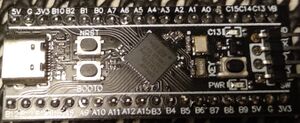Difference between revisions of "STM32 internal temperature and voltage reference"
Jump to navigation
Jump to search
| Line 1: | Line 1: | ||
| − | [[Category:C]] [[Category:STM32 Development]] [[Category:STM32CubeMX]] [[Category:STM32CubeIde]] [[Category:Embedded]] [[Category:STM32]] {{metadesc|Read ADC on STM32}}[[File:Black Pill (stm32f411).jpg|thumb|300px]] | + | [[Category:C]] [[Category:STM32 Development]] [[Category:STM32CubeMX]] [[Category:STM32CubeIde]] [[Category:STM32 HAL]] [[Category:Embedded]] [[Category:STM32]] {{metadesc|Read ADC on STM32}}[[File:Black Pill (stm32f411).jpg|thumb|300px]] |
Most - if not all - [[STM32]] [[MCU]]s have a built-in temperature sensor (and a built-in voltage reference). While this temperature sensor needs calibration to achieve any kind of precision, it is usable to detect temperature changes. | Most - if not all - [[STM32]] [[MCU]]s have a built-in temperature sensor (and a built-in voltage reference). While this temperature sensor needs calibration to achieve any kind of precision, it is usable to detect temperature changes. | ||
Revision as of 04:56, 1 June 2021
Most - if not all - STM32 MCUs have a built-in temperature sensor (and a built-in voltage reference). While this temperature sensor needs calibration to achieve any kind of precision, it is usable to detect temperature changes.
Both the temperature sensor and the internal reference voltage are hooked up to the built-in ADC.
For this example, we are going to be using a so-called Black Pill board. The Black Pill board is using a STM32F411 and according to the datasheet that MCU has got one 12-bit ADC with up to 16 channels.
